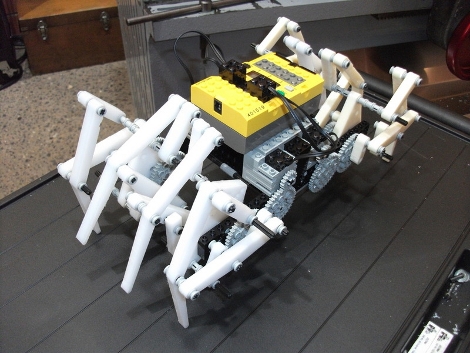
[MkMan’s] LEGO spider robot combines pieces from a Mindstorm kit with a few milled plastic parts. The legs are a locomotive concept called a Klann Linkage. They operate in pairs and convert the rotational force from one motor into movement for two legs. Here, a total of four rotating gears moves eight legs, besting the hexapods we saw a couple of weeks ago in both leg count and motor economy.
Each limb is made up of five pieces plus one base for each pair. That makes eleven pieces per pair and a total of 44 for the entire robot. [MkMan] milled these parts out of 3/8″ HDPE stock. He’s made videos of forward motion and turning which we’ve embedded after the break. Even on a polished surface the bot looks fairly efficient at getting around.
[youtube=http://www.youtube.com/watch?v=hz4mflE2foM]
Walking forward
[youtube=http://www.youtube.com/watch?v=Bl_5wCbvxMU]
Turning















Somehow, the second vid makes me want to go out and duct tape two crabs together.
Wow…very spidery. gives me that same bit of creeps as spiders, but still so very cool. I love seeing folks combining legos with other items to make something more then what is possible with just stock lego.
would it be more or less efficient with rubber feet?
@Ashmedai,
that would be interesting to see…. but I don’t think you’d get them to synchronize.
@Matt
I think that would make turning a lot harder.
@Matt
Something with a bit less friction might work, though. I know that milled plastic can be pretty smooth, maybe just rough the bottom of it with sandpaper?
I wonder if it was inspired by Strandbeest? I’ve been toying with something along those lines for a couple of years.
Looks good..Like the concept of the Klann Linkage a lot..
Heh, this is pretty cool. . .doing my usual hackaday scan and seeing my own work =)
@Matt: I’m not sure what rubber feet would do for it, I can make a case for net gain or loss. If I make another or have a student make one, we’ll have to test.
@dmoss: Yes. I looked at Jansen’s work extensively, and plan to cut LEGO compatible strandbeest legs one of these days. Incidentally, it appears that Klann may have been inspired by Jansen. He has a comparison page at http://mechanicalspider.com/comparison.html that frankly convinced me his were more efficient, so I built them first. After building these, I’ve tentatively concluded that the strandbeest would be a much better cargo hauler, where as Klann legs make a better light scout.
I was thinking of a BEAM (or tiny13 controlled) robot using cocktail straws or plastic hose with Jansen’s linkage. The Klann linkage looks like the better choice. I hadn’t been aware of it -thanks. It’s too bad the higher lift of the Klann linkage happens so late in the cycle. If it lifted earlier the ‘bot would be able to handle more uneven terrain. Sweeping forward like it does, the leg would spend the first half of it’s stroke pushing itself backwards against any obstables. Some tweaks to the geometry shown at the link might do the trick, though. Maybe it’s time to start tinkering.
Does this remind anyone else of the Hand Crabs from Doom3?